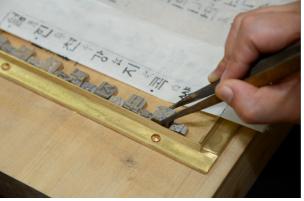Wax Casting Method
The wax casting method produces metal types by carving letters from wax, covering them with clay, baking them, and pouring molten metal into the spaces created by the melted wax.
1 Adhering the letter models to wax

First, rods of refined wax are made and then flipped and adhered to the mother letter* models.
* Mother letters are also called father (父) letters.
2 Adhering letter models to wax

Then letters are embossed, cut out, and adhered to the wax rods.
3 Making the wax branch

Each of the branches with wax letters are adhered to runners. On average, about 100–150 letters are enough.
4 Making the mold

When the runners are complete, they are covered with molding clay made out of red clay, sand, and mudstone to make the molds.
5 Pouring the molten metal

After the molds have dried, the wax is melted out and molten metal is poured into the voids.
6 Polishing the types

When the molten metal has cooled, the molds are broken and separated from the letter branch metal. The letters are then cut in even sizes and finished by having their surfaces polished.
7 Typesetting

First, the wax is laid in between the fasteners and melted. Then, the types are arranged on the strickle board frame and leveled to make printing easier.
8 Printing

The surfaces of the types are covered with lithographic writing ink. A sheet of hanji (traditional Korean paper made by hand from mulberry trees) is then placed on top of the types and evenly rubbed with a block brush.
Source: Metal Type Training Center
The wax casting method produces metal types by carving letters from wax, covering them with clay, baking them, and pouring molten metal into the spaces created by the melted wax.
1 Adhering the letter models to wax

First, rods of refined wax are made and then flipped and adhered to the mother letter* models.
* Mother letters are also called father (父) letters.
2 Adhering letter models to wax

Then letters are embossed, cut out, and adhered to the wax rods.
3 Making the wax branch

Each of the branches with wax letters are adhered to runners. On average, about 100–150 letters are enough.
4 Making the mold

When the runners are complete, they are covered with molding clay made out of red clay, sand, and mudstone to make the molds.
5 Pouring the molten metal

After the molds have dried, the wax is melted out and molten metal is poured into the voids.
6 Polishing the types

When the molten metal has cooled, the molds are broken and separated from the letter branch metal. The letters are then cut in even sizes and finished by having their surfaces polished.
7 Typesetting

First, the wax is laid in between the fasteners and melted. Then, the types are arranged on the strickle board frame and leveled to make printing easier.
8 Printing

The surfaces of the types are covered with lithographic writing ink. A sheet of hanji (traditional Korean paper made by hand from mulberry trees) is then placed on top of the types and evenly rubbed with a block brush.
Source: Metal Type Training Center